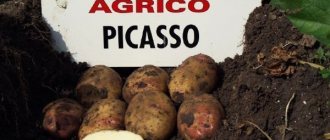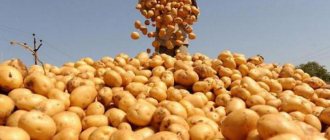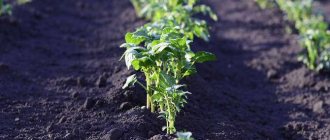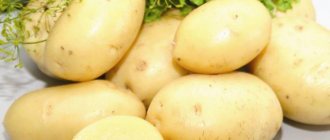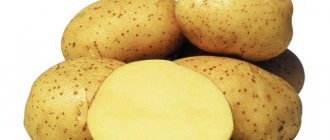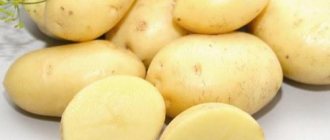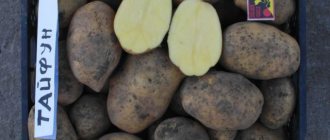Features characteristic of this variety
Many people ask why Ryabinushka potatoes are in such demand. The characteristics of the variety, reviews from gardeners, the advantages and features of this product form the system of demand for the product. Summer residents note that Ryabinushka achieved greater popularity thanks to its distinctive features, namely:
- Average ripeness period. Within 8-10 weeks there will be young potatoes on your plot, and 16 weeks after planting you can harvest.
- On average, 240-470 centners of potatoes are obtained from one hectare, which cannot be ignored. That is why Rowan is suitable for cultivation not only for personal purposes, but also on an industrial scale.
- Tubers contain up to 17.8% starch.
- Excellent taste.
- Resistance to a wide range of diseases of garden plants, including late blight. The tops of tubers are extremely rarely affected.
- Keeping quality is high. Up to 91% of the stored harvest is preserved until next spring, provided that optimal conditions for storing tubers are maintained.
- In case of mechanical damage, the flesh does not darken. Therefore, “Ryabinushka” is easily transported to any distance.
A tasty, transportable and valuable product is the Ryabinushka potato. The characteristics of the variety, reviews and advantages of the crop allow the product to occupy a leading position in the vegetable sales market in our country.
Thanks to its taste and long shelf life, this transportable product is rapidly being exported to countries not only in the near and far abroad, where it is in great demand among local residents.
A little history
Let’s start our conversation about Ryabinushka potatoes not with the description of the variety itself, but with the history of its occurrence.
This is a variety of Russian breeders from the city of Vsevolzhsk. He is relatively young, “born” in 2007. Potatoes are included in the State Register of the Russian Federation.
Over ten years, the Ryabinushka variety has spread to many regions of Russia. It is grown not only in the central regions, but also in Siberia, the Far East, and the Caucasus. Judging by the reviews, residents of the former republics of the Soviet Union also fell in love with the pink vegetable: Moldovans, Belarusians, and Ukrainians.
Attention! The Ryabinushka variety is an elite variety, it is not a hybrid.
Planting and growing potatoes Ryabinushka
To achieve high yields, it is necessary to carefully study the features of planting and cultivating this variety.
Planting potatoes can be done in two ways: seeds and tubers. Farmers use the second option much more often, due to its convenience and rapid germination.
Potato growth and crop size are influenced by factors such as:
- correct choice of soil;
- preparation of planting material;
- planting technology;
- watering;
- selection of fertilizers and fertilizing of plants;
- need for special care;
- timely treatment of plants when a disease occurs.
Preparing for landing
Work on planting potatoes begins in early or mid-May; this largely depends on the climatic characteristics of the region. The main thing in this matter is to focus on weather conditions. The danger of frost should be left behind, and the soil should warm up to about 8-10 °C.
To increase germination and enhance the growth of tubers, it is necessary to properly prepare them before planting. To do this, 3-4 weeks before the expected planting day, the tubers are calibrated by size. Potatoes the size of an egg are best suited as seed material.
It is also important to inspect the root crop. There should be no mechanical damage or signs of rotting. To prevent the development of diseases in potatoes, it is recommended to place planting material in a solution of boric acid (1%) for 20-30 minutes.
To prevent the development of diseases in potatoes, it is recommended to place planting material in a solution of boric acid (1%) for 20-30 minutes.
Soil requirements
Experienced farmers advise planting Rowanushka on those plots of land where crops such as lupine, peas, beans, cucumbers, cabbage or any grains grew the previous year. In this case, it will be possible to achieve a high potato yield.
First, a plot of land is dug up to the depth of a spade bayonet. The top layer of soil must be turned over. In addition, about 100 g of ash and 2.5-3 kg of humus can be added per 1 m² of land.
Preparation for planting potatoes begins with digging up the area
Dates, scheme and rules of planting
As a standard planting of this potato variety, a scheme in which the tubers are placed in small holes is appropriate
The distance between them should be at least 30-35 cm. It is also important to maintain row space. The optimal step is 70-80 cm. The depth of the hole depends entirely on the composition of the soil:
The depth of the hole depends entirely on the composition of the soil:
- on sandy and sandy loam soils, relatively large depressions are required, up to 10-12 cm;
- on clay soils, it is recommended to make holes no deeper than 4-5.5 cm.
Scheme for planting potatoes in holes
Advice from experienced gardeners and reviews about the Ryabinushka variety
Feedback from farmers about the Ryabinushka variety is generally positive.
Timur, Saratov: “The variety, in my opinion, greatly depends on the year - in the heat or rainy season the tubers become smaller.”
Alexandra, Volzhsk : “The Ryabinushka potato variety is a very rational variety. All tubers are the same size, there are few small things. There are no problems with preparing seed material.”
Nikolay, Novgorod : “Ryabinushka perfectly accepts feeding with fresh chicken droppings. I carry it out once a season, while the bushes are below 15-20 cm. It makes no sense to feed overgrown plants, since this no longer affects the size of the tubers.”
The main advantages and disadvantages of the variety
Ryabinushka potatoes are distinguished by their harmonious combination of many advantages that are inherent in other varieties only individually:
- undemanding to soil type and growing conditions;
- high productivity;
- tuber alignment;
- good immunity against diseases;
- resistance to golden nematode;
- good keeping quality;
- good resistance of tubers to mechanical damage (suitable for industrial processing);
- great taste.
The disadvantages of the variety include:
- susceptibility to late blight;
- reduction in yield under extreme conditions: drought or heavy rain;
- the sometimes noted tendency to degeneration - which sometimes serves as an excuse for illiterate agricultural technology.
Other potato varieties:
Selection of tubers for planting
- Select medium-sized tubers, approximately 100-110 g.
- Choose a root vegetable with a lot of eyes. The more eyes, the more shoots.
- Be sure to check the seed. Tubers must be healthy! Planting infected plants in the ground threatens the loss of part of the harvest.
- It is necessary to remove tubers with signs of fungus or other infectious diseases.
- Taste the potatoes to the touch - they may be a little soft, but not empty.
Potato variety Gala: ripening time and characteristics
There are many varieties of potatoes that differ in ripening time, taste and yield. Not every novice gardener knows about Gala potatoes
Its advantages should be taken into account. This is an unpretentious, high-yielding variety, which, in addition to all of the above, is also resistant to many diseases.
Advantages and disadvantages of Gala potatoes
There are many positive aspects to growing this variety. But there are also disadvantages that you need to familiarize yourself with before deciding to plant Gala on your site.
Advantages of the Gala variety:
- suitable for any region of our country;
- potato bushes are undemanding in care;
- unpretentious to the soil;
- is resistant to many diseases;
- has a short ripening period;
- characterized by high productivity;
- good taste;
- possibility of long-term storage.
One of the disadvantages is the fact that if the harvest is not harvested on time, the beneficial substances in root crops are significantly reduced. In addition, the Gala variety is susceptible to diseases such as late blight.
Information about the variety and main characteristics
This is a popular early potato variety that produces the first harvest after 2 months. Developed by experienced specialists from the German company Norika. Potato Gala made its presence known in our markets 11 years ago. Is a sales leader.
Tubers and yield
Productivity is high. Ripening time is 65-70 days. When harvesting, you can collect about 20 tubers from each bush. Potatoes are small in size, weighing up to 120 g. The shape is round, sometimes oval. The color of the tubers is light and uniform. Length 8-9 cm, width 5-6 cm.
Expert opinion
Stanislav Pavlovich
Gardener with 17 years of experience and our expert
Reference! From a plot of 1 hectare you can harvest up to 30 tons of potatoes.
The nutritional value
These are table potatoes. The pulp is rich in color, light yellow. The color does not change during cooking.
The nutritional value:
- starch – 13-15%;
- vitamin C – 22%;
- proteins – 1.7%;
- sugar – 0.31%.
There is little starch, more carotene. This allows Gal to supplement the diet of people who are eating healthy.
Immunity to diseases
Gala potatoes are resistant to various diseases. However, there are ailments that bushes cannot resist. Immunity to many pathogenic organisms makes the Gala variety competitive.
Favorable regions for planting
Gala potatoes are suitable for cultivation in most regions of our country. The plant adapts well to most soil types and weather conditions.
The variety is grown in the following regions:
- Novgorod;
- Yaroslavsky;
- Kostroma;
- Tversky;
- Kaliningradsky;
- Vologda;
- Pskovsky.
The variety is also popular in Belarus and Ukraine.
Soil and seed preparation
The area is treated before planting potatoes. They dig him up; remove debris, plant roots, and stones. Lucky are those gardeners whose soil is light (chernozems, alumina). In autumn, the soil is fed in advance with any type of organic matter (humus, compost).
The preparation of tubers consists of the following stages of work:
- The seeds are sorted, sorted into small and large.
- They are treated with a growth activator, which is aimed at reducing the development of pathogenic microorganisms.
- The tubers are left for a while until they germinate.
Expert opinion
Stanislav Pavlovich
Gardener with 17 years of experience and our expert
Reference! The best potatoes for planting are those with strong shoots and dense, slightly green skin.
Timing, methods and planting schemes
To understand when to plant Gala potatoes, you need to wait until the soil warms up to 10-11C°. Lower temperatures will lead to rotting of the seed material. There are two options for planting this variety. This is planting in a hole and in a row.
Next you need to mark the beds, which is suitable for two cases:
- leave 55-60 cm between rows;
- the distance between the holes is at least 30 cm;
- the depth of each pit (hole) is 14-15 cm;
- if the soil is poor, spread organic fertilizer at the bottom of the holes;
- Place one potato in the center of the hole or hole and sprinkle with soil.
There is no need to plant several potatoes in one hole. This will result in small root crops. Gala is planted from mid-March to mid-May. It all depends on weather conditions and the region of the country.
Watering
The variety does not tolerate waterlogging, so watering should be uniform. After planting is completed, it is recommended to add 1.5-2 liters of water under each bush.
Red Scarlet Potatoes
Red Scarlet potatoes are a variety originally from Holland. It has high quality characteristics, grows in middle and southern latitudes, and at the same time is early ripening. Its features, proper planting and care, storage and harvesting will be discussed below in the article.
What are the external features of the variety?
As the name suggests, the Red Scarlet potato variety has red skin, or rather deep pink. The eyes are 1-1.5 mm deep, superficial, yellowish or dark. The color of the pulp is white, less often yellowish. One of the advantages is that when cut, it does not darken for a long time in the air. The shape of the tubers is elongated, like an oval. All potatoes are smooth, beautiful, and less often you come across irregular shapes.
The bush of the plant is low, erect, and not very thick. The tops do not take long to develop. The corolla of the flower is pink to purple. The leaves are dark green and small.
Characteristics of the Red Scarlet variety
Characteristics of the Red Scarlet potato variety
Red Scarlet potatoes do best in cool, humid climates. But if the area is characterized by high summer temperatures, droughts or low humidity, artificial shade and frequent, abundant watering will help solve the problem. Shaping high ridges can also help.
- The variety is early ripening; no more than 70 days pass from planting to harvesting potatoes. Therefore, in some regions it is grown several times a year.
- The weight of potatoes varies from 50 to 120 grams. There are even larger tubers, but they are rare.
- One bush grows 12-20 potatoes of approximately the same size. Formed simultaneously.
- The average yield per hectare is 45 tons. The maximum fixed yield is 60 tons. If you collect young potatoes, you can get 25 tons per hectare. But these figures can vary significantly depending on the climate, planting and, most importantly, care.
- Drought resistance on a scale of 1 to 10 is 6.5.
- Starch content is 10-15%, according to some sources - 15-17%.
- The taste is very good, potatoes are used in the preparation of various dishes, they are prepared using all kinds of methods. Often used to make chips and French fries. Also used in cosmetology and medicine.
- Potatoes are quite dense, they can be transported over long distances - they do not spoil for a long time and are stored well.
- It does not get sick often, the variety is resistant to potato nematode, Yn virus, cancer, tuber late blight, and A virus.
- During storage, the taste does not deteriorate, and the beneficial properties are not lost.
How to plant potatoes correctly?
Planting Red Scarlet Potatoes
Soil preparation is carried out in the fall. They dig it up and apply fertilizer: peat or humus. Before and after potatoes, legumes are always planted on the plot.
Before planting, Red Scarlet potatoes need to be purchased and germinated. To do this, medium-sized potatoes are selected and left in a warm place. In a few days, sprouts will appear, and when they reach 5 mm in length, the tubers can be planted.
The crop is planted early, in late April or early May. The holes are made shallow - 12-15 cm with a distance of 70 cm between the holes. The rows are made at a distance of 0.7-1.4 meters from each other. Calcium is added to the soil; to do this, just put crushed eggshells or any available product with a high calcium content in the hole.
After the shells, the potatoes are placed with the sprout facing up. When digging holes in the next row, the previous holes are filled with earth. After this, the ground is leveled with a rake.
How to care for the Red Scarlet variety?
Caring for Red Scarlet Potatoes
The most important rules in care are watering and loosening. Without timely watering, Red Scarlet potatoes will simply stop growing - they tolerate drought, but not in the best way. And so that moisture quickly reaches the roots, and in order to provide them with a large amount of oxygen, the soil is sometimes loosened.
After the sprouts appear, the plant is hilled or simply planted in ridges. In this case, the ridges or tubercles should be 10-15 cm higher than those of all other potato varieties
It is important to remove the weed in a timely manner, as well as collect the Colorado potato beetle or spray the plant against it. The crop does not get sick often, but in order not to spoil the entire harvest, it is still regularly treated with fungicides and insecticides as a preventive measure.
Description of Ryabinushka potatoes
This variety does not have a long history; breeders from the city of Vsevolozhsk bred it in 2007. This potato is not a hybrid, it belongs to the elite varieties
Potato bushes of medium height consist of erect or semi-erect stems. The rounded leaves with a wavy edge are bright green in color. The sizes of leaves on one bush are different. At the base of the stems the leaf blades are larger, but the closer to the top, the smaller they are.
What does Ryabinushka potato look like?
Ripening time and yield
Such potatoes are usually classified as mid-early varieties. Depending on climatic conditions, it takes 80-90 days from planting to fruit ripening.
In addition to early ripening, Rowanushka is highly valued for its high yield. In one hole you can most often find 12-15 large potatoes. Thanks to this, the harvest collected from 1 hectare of land is most often about 400 centners.
Disease resistance
The list of important indicators affecting yield includes the resistance of the crop to the most common diseases. According to the breeders who developed the variety, potatoes have increased immunity against the golden nematode. Resistance to late blight is average, however, according to statistics, Rowan is relatively rarely affected by this fungus.
Characteristics of tubers
You can recognize the tubers of this variety by their oval, slightly elongated shape and red skin. Small sparse eyes are visible on the surface of the root crop. When cut, the flesh has a delicate yellowish-cream tint. If you follow all the recommendations for growing the variety, you can achieve a large tuber size. In weight they most often reach 90-130 g.
Rowanushka potato tubers weigh more than 100 g
What regions is it suitable for?
Cultivation of this variety is possible in any region, since the plant is undemanding to soil and climatic conditions. It has been noted that on fertile light soils in a climate with a lot of sunny days, this potato variety grows faster and gives the highest yield.
Taste qualities
Among the large number of different varieties of potatoes, Ryabinushka is famous for the excellent taste of the tubers. They contain 11.9-15% starch. At the same time, the consistency of the pulp is without signs of excessive dryness or watery structure. The variety is well suited for use in cooking. After heat treatment, the pulp does not lose its yellowish tint, but becomes crumbly. When cooked, whole tubers retain their shape and appetizing appearance.
These potatoes can be safely used for preparing any dishes, including baking, frying, and steaming. Rowan is well suited for making purees.
Photo
See below: potato variety Ryabinushka photo
Variety zoning - Russia (Northern, Northwestern, Central, Central Black Earth, Middle Volga, Volga-Vyatka, North Caucasus, West Siberian and Far Eastern regions), Republic of Moldova, Republic of Belarus, Ukraine.
Technical maturity occurs 2.5-3 months after emergence. It is recommended to sow after legumes, grains, perennial and annual grasses, flax, lupine, and winter crops. Safety up to 90%. Marketability up to 95%.
Planting and caring for Rowanushka potatoes
The variety is unpretentious in cultivation and care. To obtain a generous harvest, it is necessary to properly prepare the site, planting material and carry out proper care.
Selection and preparation of a landing site
Rowanushka potatoes are planted in well-warmed soil after the end of spring frosts. The planting area should be well lit and protected from gusty winds. The best predecessors are:
- cucumbers;
- cabbage;
- beet;
- greenery;
- legumes and cereals.
After tomatoes, peppers and eggplants, Ryabinushka potatoes cannot achieve a good harvest.
Chernozem, loamy and sandy soil are suitable for planting potatoes. Clay soil is very heavy, so sand and humus are added to it during digging.
Preparation of planting material
Seed material is prepared in the fall. To do this, seed potatoes the size of a chicken egg are selected and kept in the sun until a green coating appears. This vegetable will last until spring and will not be spoiled by rodents.
A month before planting, the tubers are germinated. They are transferred to a box and put away in a warm, well-lit room. After 10 days, sprouts appear. When they reach 3 cm, the potatoes, weather conditions permitting, can be planted. If the temperature is low, the sprouted potatoes are put in a dark place.
Before planting, the tubers are treated with Zircon or Epin. If seed potatoes are purchased in a store, they must undergo additional treatment against fungal diseases. To do this, the tubers are placed in warm water or a 0.1% boric acid solution for half an hour.
Harvest and storage
Growing a good harvest is half the battle. It is also important to properly remove and store it.
How and when to collect
The usual time for harvesting potatoes in the middle zone is the first half of September . Other rules include:
- Harvest in dry and sunny weather.
- The dug up tubers are scattered in one layer in the sun for 2-3 hours to dry.
- Next, the tubers are removed under a canopy or in a ventilated room for 10-14 days for “quarantine”.
- After this, the tubers are finally sorted out and stored in a cellar or dry storage. For better preservation, they can be dusted with dry wood ash.
- In parallel with this, you can select seed material for planting next year.
Storage features and keeping quality of the variety
The optimal storage temperature for the Ryabinushka variety is 3-4°C . At this temperature, its shelf life is quite satisfactory - the percentage of spoilage by spring does not exceed 10%.
Planting and caring for Rowanushka potatoes
The variety is unpretentious in cultivation and care. To obtain a generous harvest, it is necessary to properly prepare the site, planting material and carry out proper care.
Selection and preparation of a landing site
Rowanushka potatoes are planted in well-warmed soil after the end of spring frosts. The planting area should be well lit and protected from gusty winds. The best predecessors are:
- cucumbers;
- cabbage;
- beet;
- greenery;
- legumes and cereals.
After tomatoes, peppers and eggplants, Ryabinushka potatoes cannot achieve a good harvest.
Chernozem, loamy and sandy soil are suitable for planting potatoes. Clay soil is very heavy, so sand and humus are added to it during digging.
Preparation of planting material
Seed material is prepared in the fall. To do this, seed potatoes the size of a chicken egg are selected and kept in the sun until a green coating appears. This vegetable will last until spring and will not be spoiled by rodents.
A month before planting, the tubers are germinated. They are transferred to a box and put away in a warm, well-lit room. After 10 days, sprouts appear. When they reach 3 cm, the potatoes, weather conditions permitting, can be planted. If the temperature is low, the sprouted potatoes are put in a dark place.
Before planting, the tubers are treated with Zircon or Epin. If seed potatoes are purchased in a store, they must undergo additional treatment against fungal diseases. To do this, the tubers are placed in warm water or a 0.1% boric acid solution for half an hour.
Landing rules
Planting potatoes is not a difficult task. It doesn't take much time or effort. Yield depends on compliance with the rules:
- In the spring, after the end of spring frosts, the beds are dug up and filled with urea.
- It is better to make ridges in the direction from north to south with an interval of 80 cm.
- Potatoes are placed in a hole to a depth of 6-10 cm, the distance between holes is maintained at 30 cm.
- When planting, each hole is filled with wood ash and covered with a small layer of nutritious soil.
- Place potatoes on top, sprouts up.
- The holes are filled with earth so that ridges 10 cm high are formed.
Watering and fertilizing
To obtain a generous harvest, potatoes require regular watering. The frequency of irrigation depends on climatic conditions and the growing region.
Proper watering of potatoes:
- 14 days after planting, when the seedlings grow by 10-15 cm;
- during the appearance of flower ovaries, when tubers begin to form;
- with intensive tuber formation.
For rapid growth and development, Rowanushka potatoes need 3 feedings per season.
- When the plant reaches 15 cm, nitrogen fertilizers are used for this. Fertilizing must be applied strictly according to the instructions, since if there is an excess of nitrogen, the plant will begin to grow green mass to the detriment of the harvest. If the planting material is planted in nutritious soil, the first feeding can be abandoned.
- At the moment of formation of the ovaries. Phosphorus-potassium fertilizers are used for feeding. For better flowering, add 1 tbsp to a bucket of water. ash and 1 tbsp. l. potassium sulfate.
- A month before harvest. Mineral and organic fertilizers are used as fertilizer. Per 10 liters add 30 g of superphosphate and 250 ml of slurry. Half a liter of fertilizer is used per bush.
Loosening and weeding
After each watering, loosening and weeding are carried out. Regular removal of weeds will protect the plant from diseases and pests.
Loosening will provide quick access of oxygen to the roots. Under the earthen crust, the tubers stop developing and begin to dry out. The first time the soil is loosened before emergence, on the 6th day after planting. Further loosening is carried out as necessary.
Hilling
In order for the tubers to grow quickly and develop well, the bushes must be hilled. This procedure:
- stimulates bush growth;
- improves oxygen access to roots;
- gets rid of weeds.
Hilling can be carried out in 2 ways: classic and fan.
Classic - the bush is covered with earth on both sides, raking a high mound onto the bush.
Fan - the soil is laid not on the side, but in the center of the bush. To do this, the tops are moved apart in the center and covered with earth, grass or straw. This method does not look as beautiful as with classic hilling, but the yield increases almost 2 times. The procedure is carried out early in the morning or after sunset, not forgetting to water the bushes generously.
If the summer is hot and frequent irrigation is not possible, it is better not to do hilling. Since the dryness and heat of the hilled bushes can cause potatoes to bake directly underground.
Diseases and pests
From the description it is clear that the Ryabinushka potato has strong immunity to many diseases. But if the care rules are not followed, the tubers can be affected by the following ailments:
- Late blight is a fungal disease. The disease can be detected by the appearance of the tops. Dark brown spots appear on the leaves, and the basal part of the trunk becomes covered with a dark coating. The plant becomes lethargic and quickly dies without treatment. You can help the plant by treating it with a solution of copper sulfate.
- Fusarium wilt is a fungal disease that leads to the rapid death of the plant. During an outbreak of infection, up to 50% of the crop can be lost. The disease develops rapidly and is at its peak during the flowering period. The disease can be recognized by yellowing, wilting and curling of the leaves; the bottom of the tops is covered with a multi-colored coating. If a plant is infected with fusarium, it will not be possible to save it.
- The Colorado potato beetle is a frequent visitor to the southern regions. For destruction, insecticides are used: “Iskra”, “Karate”, “Prestige”. Processing is carried out strictly according to the instructions.
To avoid problems, it is necessary to follow preventive measures:
- adhere to crop rotation;
- disinfect planting material;
- remove weeds in a timely manner;
- 2 weeks before harvesting, mow the tops;
- till the soil before planting.
Features of planting and growing
Agrotechnical methods for growing the Ryabinushka variety are traditional.
Preparing for landing
About a month before planting, potatoes should be started for germination. It is most rational to use potatoes approximately the size of a chicken egg, with an average number of eyes.
Selected tubers are laid out in one layer in boxes or on matting and left in the light at a temperature of about +20°C. After about 5-7 days, the first shoots should appear.
After this, the seed material is removed to a cool place (10-12°C) until planting.
Before planting, tubers should be pickled in a solution of copper sulfate for disinfection. Methods for preparing the mixture:
- copper sulfate – 20 g, potassium permanganate – 1 g, water – 10 l;
- copper sulfate – 5 g, boric acid – 10 g, potassium permanganate – 1 g, water – 10 l.
If tubers are cut into pieces for planting, then after each cut the knife should be dipped in a solution of copper sulfate, and the cut should be sprinkled with wood ash.
Soil requirements
The Ryabinushka variety is not very demanding on the composition of the soil, but prefers areas with fertile light soil - sandy loam.
Fertilizers, including organic ones, are applied in the fall, during plowing or digging.
The best predecessors are grains or legumes: peas, beans, as well as perennial green manure grasses - alfalfa, lupine.
Dates, scheme and rules of planting
The timing of planting the Ryabinushka variety is the same as for planting potatoes, traditionally accepted in a particular region. In central Russia, they usually fall on the May holidays, when the onset of warm weather conveniently coincides with several non-working days.
Planting pattern:
- square-cluster method with a distance between holes of 25-30 cm;
- in rows with a distance between bushes of 25-30 cm and a row spacing of 50-70;
- The seeding rate per hundred square meters is 27-29 kg, that is, about three buckets of seed potatoes.
A hole is dug half the length of a shovel (about 10 cm), seed potatoes are laid, if possible, half a ladle of wood ash is added, sprinkled with earth and leveled.
On light to medium soils, you can get by with just one shovel and rake. On heavy and clayey soils, a walk-behind tractor will be a good help, and in this case it is more profitable to plant potatoes in ridges.
Features of cultivation and nuances of care
Growing potatoes of the Ryabinushka variety has no specific features and is carried out according to standard rules.
Watering
In hot weather or prolonged drought, when there has been no rain for more than a week, Ryabinushka, like any variety of potato, requires watering. The most convenient way to water potatoes is with a hose, directing the water along the rows. When watering a small area with a watering can, the approximate norm is one bucket per square meter. m. Watering is done once a week in the evening.
Loosening
Loosening of row spacing should be carried out once a week, the day after watering or (unscheduled) after heavy rain.
Weeding and hilling
Weeding is usually combined with loosening. In the first half of the growing season it is carried out 1-2 times a week, in the second half - once a month.
Hilling - at least twice per season: the first - at the end of May, when the shoots reach 10-15 cm, the second - at the beginning of flowering. After heavy rains, when the ground around the bushes settles, additional hilling may be required.
Top dressing
The Ryabinushka variety accepts both mineral and organic fertilizing well.
First feeding: at the germination stage. Approximate composition:
- Urea – 1 tbsp. l., water – 10 l.
- Mullein – 0.5 l, water – 10 l, leave for 3-5 days.
- Chicken manure – 0.5 l, water – 15 l, leave for 3-5 days.
Consumption – 0.5 l per bush.
Second feeding: at the stage of bud formation. Ingredients: potassium sulfate - 1 tbsp. l., wood ash – 1 tbsp., water – 10 l. Consumption – 0.5 l per bush. This fertilizing accelerates the onset of flowering.
Third feeding (during flowering): superphosphate – 2 tbsp. l., mullein - 1 tbsp., water - 10 l. Consumption – 0.5 l per bush.
Disease and pest control
The main attack on potatoes is the Colorado potato beetle. In a small area, it can be collected manually or, in case of severe infection, chemical insecticides “Decis”, “Aktellik”, “Karbofos”, etc. can be used.
When potatoes are affected by fungal diseases - scab, late blight, Alternaria blight, etc. – after an accurate diagnosis of the disease, fungicides “Quadris”, “Uniform”, “Shirlan” or similar are used.
Prevention:
- Treating tubers before planting with Tirana and Maxim products will help prevent the appearance of the Colorado potato beetle.
- For the prevention of diseases, incl. late blight, tubers are treated with copper sulfate before planting.
- Only healthy tubers should be used for planting.
- In order to repel pests, it is worth planting strong-smelling plants, aromatic herbs, and calendula in the rows.
- A universal preventive measure is strict adherence to crop rotation.
Rules for storing elite potatoes
After harvesting, you should think about storing it.
Leave the potatoes for 12 days to ripen and dry. After this, you need to start sorting what is for seeds, what is for the needs of the farm, what is for food.
Seed material is selected in the fall. After all, it still needs to be prepared for wintering. For future plantings, we select potatoes of the Ryabinushka variety based on size, without damage or signs of disease. We wash it and put it in the sun for landscaping. This way, the seeds are stored better.
Seed material is stored separately from food material. You can use bags or boxes, as in the photo. In the basement you need to maintain a certain temperature and humidity.
How to properly care for the variety
The basic requirements for caring for this variety are standard, but small features should be taken into account. They can significantly affect the yield of a variety.
Features of watering
The Ryabinushka potato variety requires more frequent watering than most other varieties, but this will not bring much trouble to farmers. Over the entire season, potatoes will need to be watered 3-4 times. If cultivation is carried out in a region with a hot climate, then the number of waterings can be increased up to 4-5 times.
- Water the soil for the first time after the potatoes emerge. The sprouts should already reach a height of 10-15 cm at this time.
- The beginning of flowering of the tops is a good time to re-water.
- Another watering is recommended after flowering ends. In most cases this is enough for good growth.
Feeding and fertilizing
If planting is carried out in fertile soil, then additional fertilizer is not required for potatoes. On the contrary, practice shows that excess nutrients in the soil slows down the growth of tubers. The result of such actions will be low yield.
If the soil is fertile, then the only requirement is autumn fertilizing. It is carried out during the harvesting of crop tops and digging up the top layer of soil.
Spring fertilizing is recommended only if the soil on the site is heavy and lacks nutrients. A mixture of ash and humus is used as fertilizer.
Hilling and weeding
Hilling and loosening the soil around a potato bush is an important requirement for achieving high yields. This procedure has several functions:
- weed removal. They interfere with the growth of potato tops and consume nutrients;
- providing oxygen access to the roots;
- preventing soil drying out.
Hilling up potatoes is an important part of care that should not be skipped.
Seed treatment before planting
Immediately before planting, seed potatoes are soaked in a solution of boric acid (for 25-30 minutes) or copper sulfate (for 3-6 minutes).
The potatoes are laid out in dug holes with a depth of no more than 10 cm and a distance between adjacent holes of 25-30 cm, dusted with ash and covered with soil from the garden bed.
Now you know how to plant potatoes correctly, and you will definitely cope with this task if necessary.
How to sprout potatoes
To speed up growth and increase yield, potatoes can be sprouted. The procedure is quite clear and simple, and brings really excellent results.
You will need a shallow box, potatoes, soil. A 2-3 cm layer of soil should be added to the bottom of the box. The soil should be moistened and the soil temperature should be maintained at 15C.
Root crops are placed with their eyes up, a layer of potatoes is covered with 2-3 cm of soil. Next, the next layer is laid out. There should not be more than 3 layers in one box.
The filled box is exposed to light to speed up germination. Important: the temperature remains within 15 C.
After just 2 weeks, the tubers will be ready for planting in the ground. The height of the sprouts should not exceed 1.5 cm. If the tuber has not sprouted into the soil, it is not planted, but is left to germinate further.
Prevention and increasing the efficiency of germination - treatment with copper sulfate in the proportion of 5 liters of water to 1g of vitriol.
You may be interested in:
